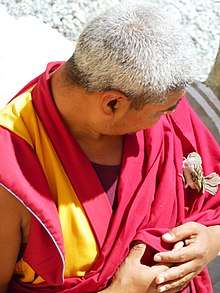Sentient beings (Buddhism)
| Part of a series on |
| Buddhism |
|---|
 |
|

In Buddhism, sentient beings are beings with consciousness, sentience, or in some contexts life itself.[1] Sentient beings are composed of the five aggregates, or skandhas: matter, sensation, perception, mental formations and consciousness. In the Samyutta Nikaya, the Buddha is recorded as saying that "just as the word 'chariot' exists on the basis of the aggregation of parts, even so the concept of 'being' exists when the five aggregates are available."[2] While distinctions in usage and potential subdivisions or classes of sentient beings vary from one school, teacher, or thinker to another, it principally refers to beings in contrast with buddhahood. That is, sentient beings are characteristically not enlightened, and are thus confined to the death, rebirth, and dukkha (suffering) characteristic of saṃsāra.[3]
However, Mahayana Buddhism simultaneously teaches that sentient beings also contain Buddha-nature—the intrinsic potential to transcend the conditions of saṃsāra and attain enlightenment, thereby obtaining Buddhahood.[4]
In Mahayana Buddhism, it is to sentient beings that the Bodhisattva vow of compassion is pledged. Furthermore, and particularly in Tibetan Buddhism and Japanese Buddhism, all beings (including plant life and even inanimate objects or entities considered "spiritual" or "metaphysical" by conventional Western thought) are or may be considered sentient beings.[5][6]
Definition
Getz (2004: p. 760) provides a generalist Western Buddhist encyclopedic definition:
Sentient beings is a term used to designate the totality of living, conscious beings that constitute the object and audience of Buddhist teaching. Translating various Sanskrit terms (jantu, bahu jana, jagat, sattva), sentient beings conventionally refers to the mass of living things subject to illusion, suffering, and rebirth (Saṃsāra). Less frequently, sentient beings as a class broadly encompasses all beings possessing consciousness, including Buddhas and Bodhisattvas.[1]
Classification
Early scriptures in the Pāli Canon and the conventions of the Tibetan Bhavacakra classify sentient beings into five categories—divinities, humans, animals, tormented spirits, and denizens of hell—although sometimes the classification adds another category of beings called asuras between divinities and humans.[1]
See also
References
- 1 2 3 Getz, Daniel A. (2004). "Sentient beings"; cited in Buswell, Robert E. (2004). Encyclopedia of Buddhism. Volume 2. New York, USA: Macmillan Reference USA. ISBN 0-02-865720-9 (Volume 2): pp.760
- ↑ David Kalupahana, Causality: The Central Philosophy of Buddhism. The University Press of Hawaii, 1975, page 78.
- 1 2 Kimura, Kiyotaka (1991). The Self in Medieval Japanese Buddhism: Focusing on Dogen; cited in Philosophy East and West; Volume 41, Number 3, July 1991. University of Hawaii Press: pp.327–340. Accessed 22 October 2008.
- ↑ Muller, Charles A. (1995). "The Key Operative Concepts in Korean Buddhist Syncretic Philosophy: Interpenetration (通達) and Essence-Function (體用) in Wŏnhyo, Chinul and Kihwa". Bulletin of Toyo Gakuen University. Archived from the original on August 28, 2008. Retrieved 2008-10-21.
In Buddhism, t'i [體] is regarded as the fundamentally enlightened Buddha-mind that is present in all beings, whereas yung [用] is the manifestation of that mind in actual practice—whether it be a full manifestation (enlightened Buddha) or limited manifestation (ignorant sentient being).
- ↑ Keiji, Nishitani (ed.)(1976). The Eastern Buddhist. 9.2: p.72. Kyoto: Eastern Buddhist Society; cited in Dumoulin, Henrich (author); Heisig, James (translator); and Knitter, Paul (translator)(2005). Zen Buddhism: A History ~ Volume 2: Japan. With an Introduction by Victor Sogen Hori. Bloomington, Indiana, USA: World Wisdom, Inc. ISBN 978-0-941532-90-7
- ↑ Ray, Reginald A. (2000). Indestructible Truth: The Living Spirituality of Tibetan Buddhism. The World of Tibetan Buddhism. 1. Boston: Shambhala Publications, Inc. pp. 26–27. ISBN 1-57062-910-2. Retrieved 2008-10-21.
In the traditional Tibetan view... the animate and inanimate phenomena of this world are charged with being, life, and spiritual vitality. These are conceived in terms of various spirits, ancestors, demigods, demons, and so on. One of the ways Tibetans recognize a spirit is through the energy that collects in a perceptual moment. A crescendo of energetic "heat" given off by something indicates a spirit. It is something like when we might say that a rock, a tree, or a cloud formation is "striking" or "dramatic" or "compelling." A rock outcropping that has a strange and arresting shape, that perhaps seems strong and menacing, will indicate the existence of some kind of non-human presence. Likewise, a hollow in a grove of trees where a spring flows and the flora are unusually lush and abundant, that has a particularly inviting and nurturing atmosphere, will likewise present itself as the home of a spirit. The unusual behavior of a natural phenomenon or an animal will suggest the same as will the rain that ends a drought or the sudden irruption of an illness.